Contact Us
University of California Cooperative Extension Ventura County
669 County Square Drive, Suite 100
Ventura, CA 93003
Phone: 805.645.1451
Fax: 805.645.1474
Office Hours:
Monday - Friday from 9 a.m. to 4 p.m.
The office will be closed for the following holidays:
Pruning Small Trees and Shrubs
Recognizing good pruning
Well-pruned landscape shrubs and trees have a natural look—they do not look pruned. Good pruning is essentially invisible. Well-pruned plants are often found in well-designed and maintained landscapes. When pruning cuts run to extremes, or large amounts of foliage are removed, it is wise to question the suitability of the individual plant in its current location (figure 1). Poorly adapted plants are not likely to have good pruning outcomes. Excessive control of rampant growth, removal of deadwood or diseased limbs will usually result in an ugly plant. The time spent on fine pruning often ends up as a HIGH COST removal. Proper design, spacing, planting and installation of landscape plants will accommodate high quality pruning that maintains the natural form and density of the plantings.
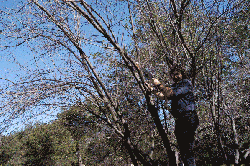
|
|
Figure 1 - Jim trying to do good pruning but failing--note peeled bark! |
The science of pruning
Physiological response to pruning in woody plants Plants respond to pruning in a variety of ways that relate to the amount and kinds of growth that are removed from the plant. In general: PRUNING IS A GROWTH RETARDING PROCESS. This means that the more you prune something the less it will grow (figure 2). Even though there may be copious growth after pruning, the amount of caliper put on below the pruning (on the main stem or branches) will always be less for the lightly or unpruned parts compared to the heavily pruned stems. This stunting is a result of removal of the photosynthetic machinery of the plant. The more leaves, stems and buds that are removed, the less food, and hormonal regulation the plant has available to produce and direct new growth. Severe pruning will result in severe stunting, in some cases, while other trees or shrubs, seem unphased. Continual heavy pruning will stunt or kill some trees, while some shrubs will tolerate the practice quite well. This may relate to the ecological adaptation of shrubs to herbivory. Essentially, they are adapted to being clipped constantly. Most trees are poorly adapted to being topped on a regular basis.
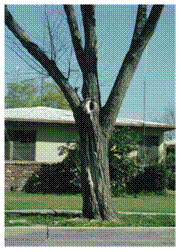
|
|
Figure 2 - poor vigor in over pruned elm. Note epicormic growth. |
Pruning is also a BUD INVIGORATING PROCESS. When the buds have desirable arrangements, (axial or lateral buds) they are stimulated by pruning and will grow in predictable ways that lead to a natural form. Buds on pruned plants are exposed to more sunlight and will be invigorated. Bud invigoration leads to larger leaves, flowers and fruit. This is especially important in fruit production. Regular pruning ensures continued production of high quality (large) fruit low in the tree.
Heavy pruning, topping or heading back or shearing often stimulates the growth of latent buds that in turn produce shoots in random patterns within the plant. Latent buds are preformed buds that occur all over the stems of woody plants. There is no uniform arrangement of latent buds, so that when they are released to grow (after a heavy pruning) they result in rampant unorganized growth that will require greater training in future pruning sessions.
Photosynthesis
Photosynthesis is the energy producing reaction that occurs in the leaves of plants. When sunlight enters leaves, the energy in the light is used to assemble glucose molecules. The energy stored in sugar is then used to run other biochemical reactions in the plant including the metabolism of roots (they have no other source of energy). Leaves are the only source of energy for a tree. The more leaves that are cut from a tree, the less it will grow. The more twigs, buds and stems removed in pruning the fewer leaves produced.
Food storage and energy depletion
Trees need energy to grow. Energy obtained from the sun via photosynthesis. When trees are well foliated, they produce enough energy for the tree with considerable reserves left over. Left over energy is stored in wood as starch. If wood is lost (pruning or decay fungi) the energy stored in the tree is lost and if not replaced, the tree will decline. Energy reserves can be viewed as a checking account with photosynthesis making deposits, and decay fungi and tree trimmers making withdrawals. When withdrawals exceed deposits, the tree will start to die. The photo (figure 3) shows branches with starch (dark stain) and those depleted by wood decay fungi (no stain). Note the bark separating from the wood at the vascular cambium.
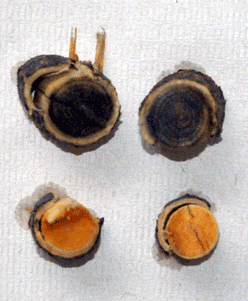
|
|
Figure 3 - Starch accumulation in healthy (top) and diseased below Acacia. |
Vascular cambium
Trees and shrubs are woody plants. They differ from begonias and grasses in that they have a vascular cambium and cork cambium that produce both bark and wood. The vascular cambium is a thin region of cells that separates the bark from the wood. If the vascular cambium is destroyed, the production of bark and wood will stop and the tree or shrub will develop a flat side as enlargement of the stem ceases. Sometimes the vascular cambium produces more cells on one side of a tree limb or stem than the other, leading to a swollen or oval shape. Extra wood is formed in response to strain that the architecture of the tree has imposed on the branch or stem. Wood and bark production by the vascular cambium does not have to be even.
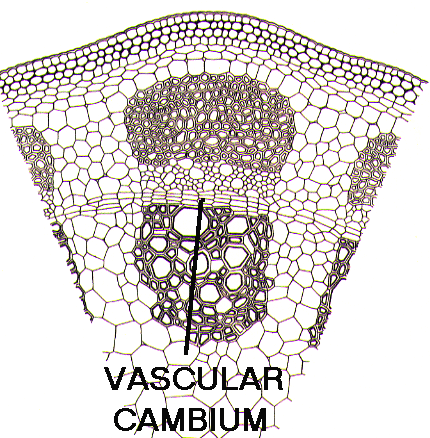
Wound response and decay
Although woody plants do not "heal" pruning cuts, they can cover them over. There is meristematic tissue around the branch collar that will form wound wood a reaction tissue that will cover over the pruning cut. Although some research has shown that a large flush cut will produce more wound wood (callus), this is not necessarily desirable because the flush cut allows decay to penetrate deeper into the stem before the cut is covered over. A smaller (more round) cut that is not flush to the attachment will cover quickly and limit the ingress of decay fungi. Shigo also maintains that decay is limited by barrier zones that form in the regions below the cut, therefore the branch collar, branch bark ridge and any other branch attachment morphologies should be preserved during branch pruning. It is no longer recommended to use pruning paints, sealers or wound dressings.
Natural Pruning—Understanding plant/tree form
Natural pruning or pruning to maintain the natural shape of a shrub or tree requires that you understand the ultimate size and mature form or shape of the plant that you prune. Natural pruning may not be appropriate for shrubs planted and maintained as topiaries, there may not be enough room to "let them loose". Shrubs generally have low branches that arise from multiple locations near the soil. Trees usually have a trunk that branches emanate from. Shrubs usually end up in the same form with only slight variation. Some may tend more toward a ground cover or creeping vine, but they are largely globular in form. Sometimes shrubs can be trained to resemble small trees and vice versa.
Trees have definite form that is a continuum between the excurrent (upright pine tree shaped) form to the deliquescent or decurrent form. The form that a plant attains is regulated by plant hormones. Although the form can be changed with pruning, the more that we try to change the innate form of a plant, the greater the pruning inputs that will be required. An understanding of the basic form of the plant will guide a natural pruning process.
Time of pruning
This depends on your goals and objectives. In Southern California, we grow a variety of evergreen or short season deciduous plants that can be pruned at any time without harm to plant form or function. In general, pruning of deciduous plants is best accomplished in the fall or winter during their dormant season. There are however exceptions. If growth reduction is the main objective, a late spring to early summer (now) pruning after most new growth has formed, will have the greatest overall growth limiting effects. Fall and winter pruning will heighten flowering of trees and shrubs that flower on new growth. Pruning during the early spring is not recommended in some cases because of slipping bark that is prone to peeling (Shigo, 1989). Since most wood decay fungi sporulate in the fall, Shigo theorized that this is a bad time to prune, however the progress of decay in fall cuts vs. other times of the year has not been well investigated.
Making cuts
Kinds of pruning cuts
There are two basic pruning cuts and then variations of the two. Heading cuts are where terminal branches are cut back severely or to a lateral branch not large enough to assume the dominance of that part of the plant. Thinning cuts remove entire buds, twigs or braches at their point of attachment.
Heading cuts are used when shearing or topping and thinning cuts are used for natural pruning effects.
When making cuts it is a good idea to prune outside the branch bark ridge or the branch collar. Preserving these areas will lead to rapid wound closure and the delimitation of decay in the main stem.
On small branches that can be pruned with loppers or clippers, orient the pruning tool to make the smallest possible wound outside the collar area of the branch. On larger branches or when using a pruning saw, to avoid peeling bark, use a three part cut, ie., an anti-peel cut(1), a weight reduction cut (2) and the final cut (3) (Figure 4).
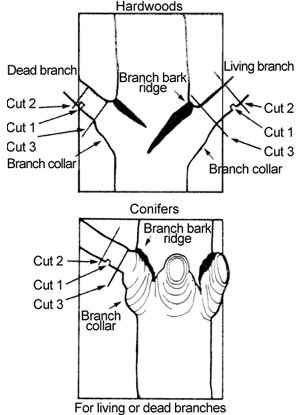
|
|
Figure 4 - From Shigo. These diagrams show the branch morphology you need to know to make "gooed" cuts. |
Sharpen your tools!
Dull clippers, loppers or saws create a jagged cut that is more prone to peeling or decay than cuts made with sharp equipment. For hand equipment a small triangle or flat file will "tune-up" your clippers in just a few minutes time. Care must be taken to file only the side to the inside of the pruning hook on bypass type clippers, otherwise a gap will be created that leads to peels and poor cuts.
Get close to the cut
The farther you are from the cut the lower the quality. Cuts made from pole equipment degrade proportionately with the number of pole extensions attached to the saw or pruner. This is because it is difficult or near impossible to achieve the correct angle and control of the pruning equipment at a distance to effect a good cut. If possible, always get close to the cut and make it with hand equipment.
Spreading disease with your cuts?
Although infectious diseases can be spread by mechanical transmission via clippers these are the exception not the rule. In most cases we do not need to sterilize cutting tools between cuts or plants. The disease fireblight caused by Erwinia amylovora is very infectious and can be spread as droplets of bacterial ooze are produced in the springtime. However, Bob Raabe at University of California Berkeley notes that most infections occur on peduncles of flowers and the bacteria are most likely spread by pollinators. In attempting to transmit the disease with clippers over the thirty-year period of his teaching career, he was never able to achieve infections via hand clippers. In contrast to fireblight, the disease fusarium wilt of palm caused by Fusarium oxysporum f.sp. canariensis is easily spread by pruning saws To avoid spreading palm wilt we recommend changing saws between trees or undergoing a rigorous sterilizing process. It is convenient to recommend the sterilization of clippers whenever dealing with disease but in many cases this is costly and damaging to the pruning equipment. A thorough understanding of the disease(s) involved is the best guide to undertaking a pruning tool sterilization process.
Treating the Cut
The use of pruning paints, wound dressings, tree sealants or other concoctions has been shown in numerous studies to be of little value in the science of pruning A good review of the subject can be found in Harris, Matheny and Clark, 2004 (pp347-348).
Shrub pruning
Shrubs can be pruned in a manner similar to that used on trees. This will lead to a natural shape. The growth responses to pruning are no different on shrubs. Most shrubs are adapted to withstand herbivory. Because of this, shrubs are often able to withstand repeated shearing or use of heading type cuts. Just as in shade trees, clear objectives need to be understood before pruning shrubs. There are two broad categories of shrub pruning. These are: natural pruning and formal or topiary pruning. Both produce very different results and depending on the species of plant used can be sustained for long periods. There are some plants like Escallonia that do not persist under topiary conditions and they should only be maintained with the natural pruning system. The main difference in these systems is that the natural pruning method for shrubs uses thinning cuts, while the topiary method uses heading (shearing) cuts.
To implement the natural shrub pruning system, start by cleaning out the center of the shrub to allow light penetration throughout the plant. This will leave open areas or holes that will fill in as light stimulates the production of new branches. One drawback of the natural pruning method is that shrubs can grow large and outgrow their allowed space. This is often why the shearing method is used, to keep shrubs in a confined area. Size reduction cuts can also be used on shrubs. Upright branches should be trimmed back to a lateral branch. This leaves a natural form and hides the cuts.
The biggest problem in pruning shrubs comes when we have to confine the shrub to a small place with pruning as the remedy. If this is the case, sometimes the shrub can be pruned right to the ground and you can start all over by training the new shoots to a smaller form. Most of the time, removal and selection of a better-adapted plant is the best way to go.
References
Harris, R.W., N. Matheny and J. Clark. 2004. Arboriculture Integrated management of landscape trees shrubs and vines. Prentice Hall, Upper Saddle River, Nj.
Shigo, A. L. 1989. Tree Pruning a Worldwide Photo Guide. Durham, NH. Shigo and Trees Associates.
